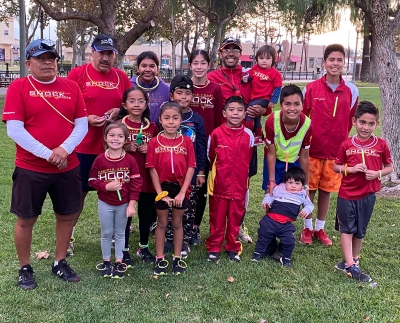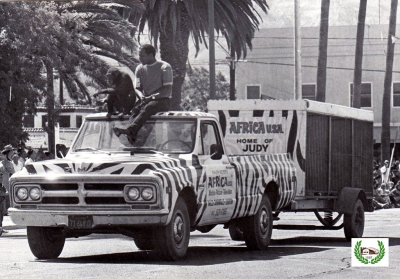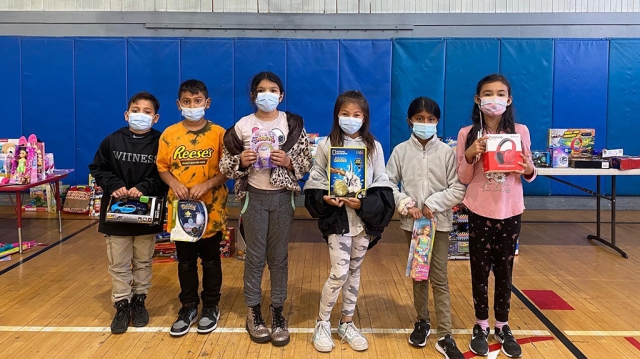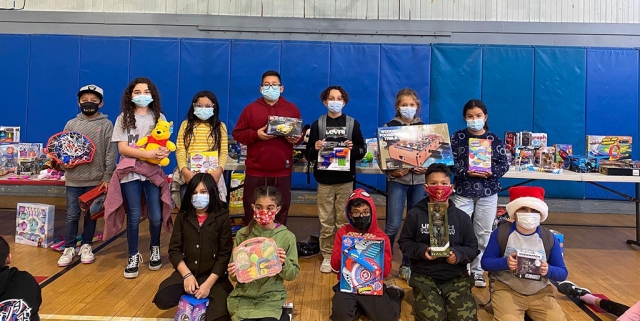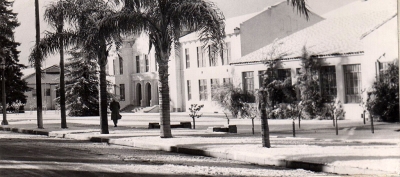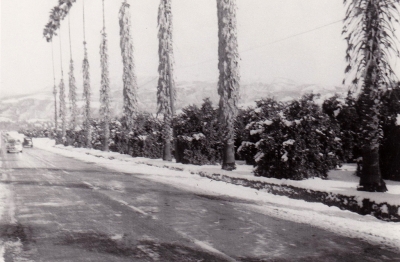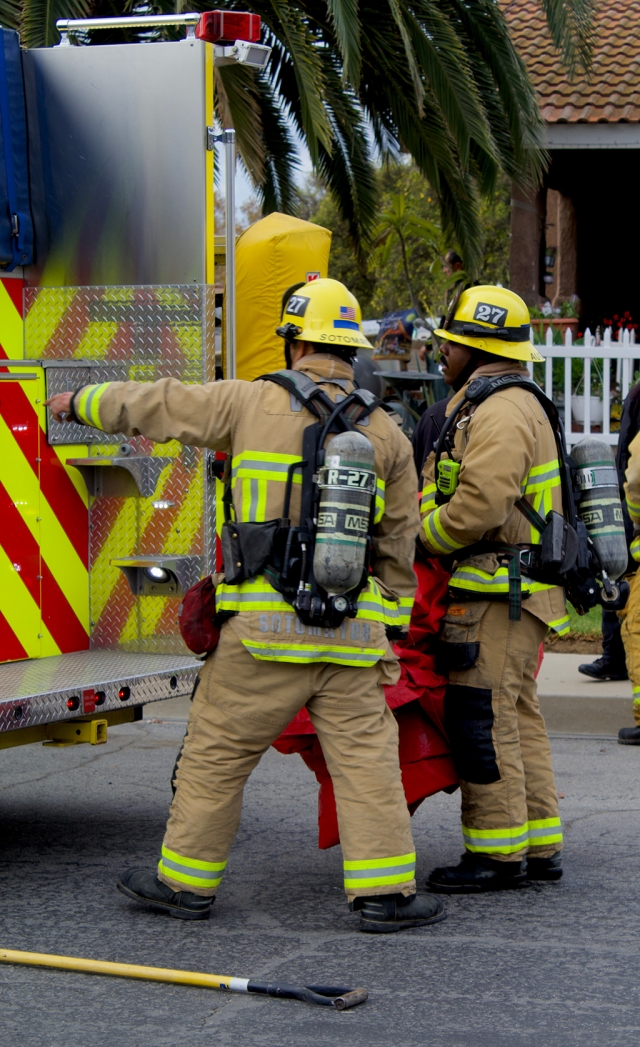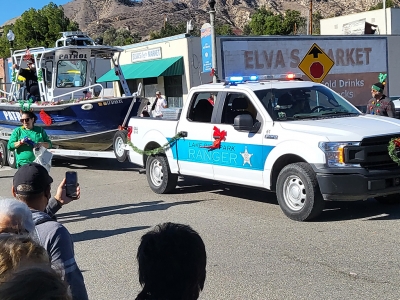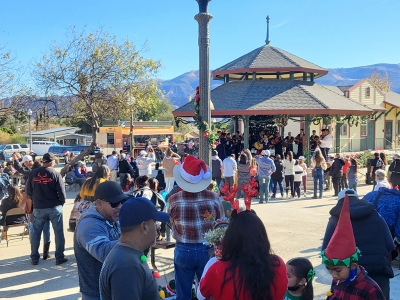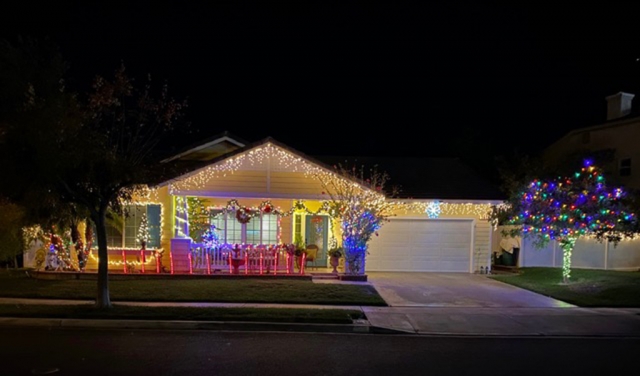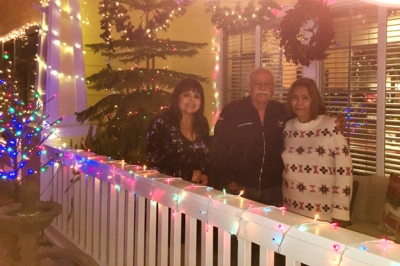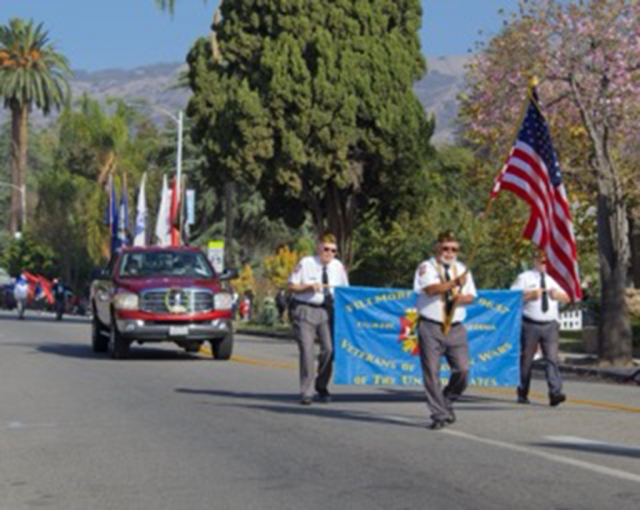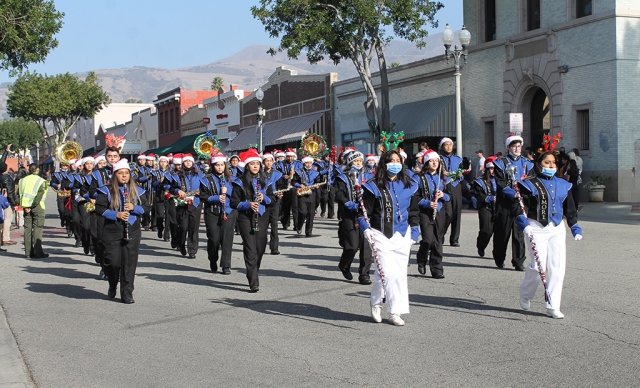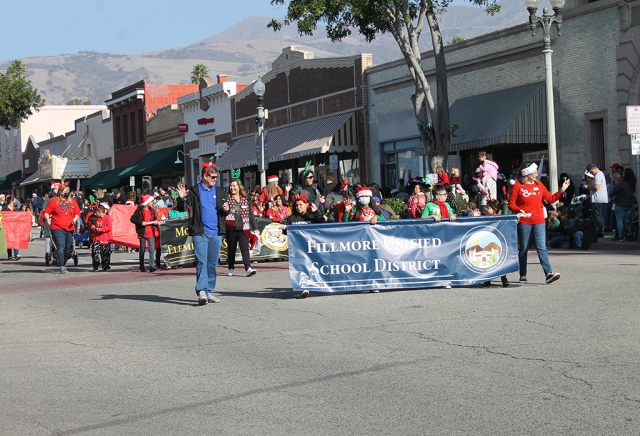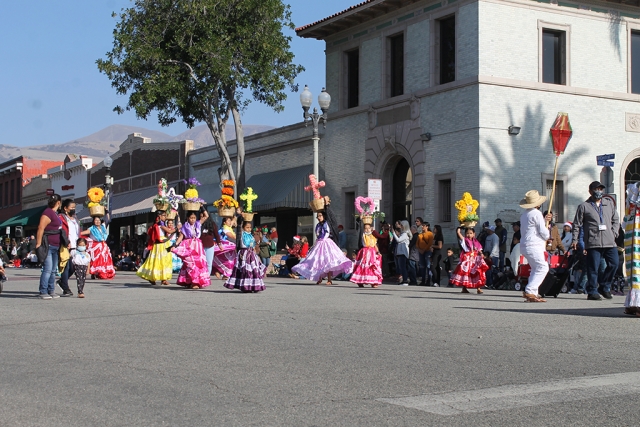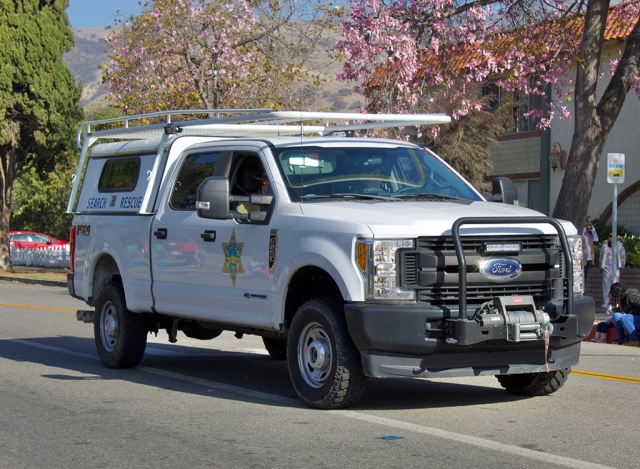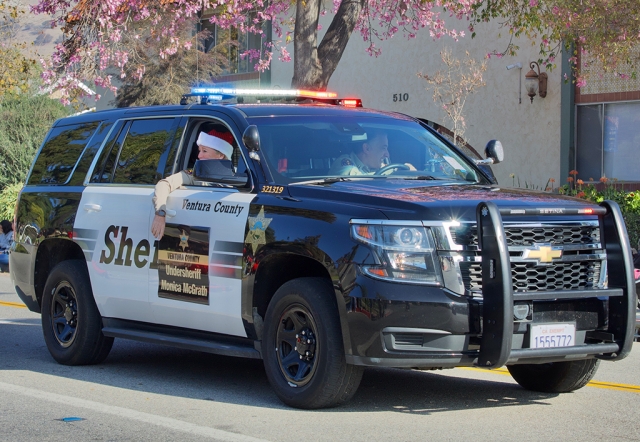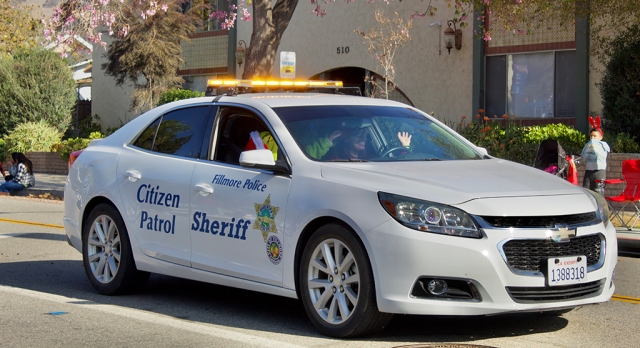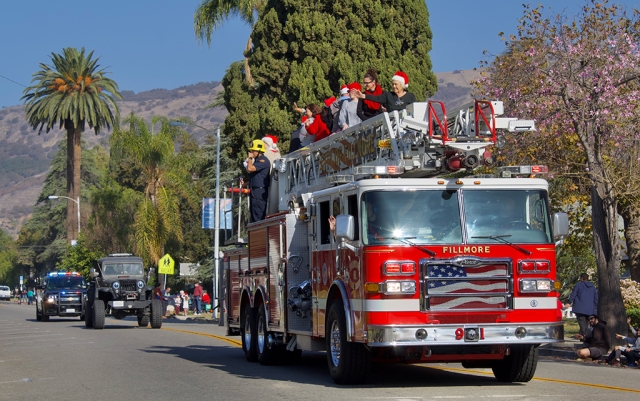 (l-r) (top-row) Paola Estrada, Isrrael Estrada and Niza Laureano. (bottom-row) Leah Laureano, Kamila Estrada, and Aaliyah Tarango. All competed at the AAU Jr. Olympics on December 4th in North Carolina. Photos courtesy Katrina Estrada. Enlarge Photo By Gazette Staff Writers — Wednesday, December 29th, 2021
Courtesy Katrina Estrada The Pacific Coast Shockwaves Fillmore concluded their cross country season by participating in the AAU Jr. Olympic which took place Saturday, December 4th 2021 at Charlotte, North Carolina. Our Fist local runner was our coach Isrrael Estrada. Running the open master 5k course in 20:49.48 and placing 9th place overall and 2nd in his group age 40/44. Bringing to fillmore the silver medal. Niza Laureano was our next runner athlete running 4K 14/15 group age with a time of 16:19.02 she placed 63rd overall out of 185 girls and placed 22nd in her group age 14years old. She helped her team to reach the podium as a 1st place team. Bringing to Fillmore 2 medals. Following were the girl’s 11 and 12 years old division. Paola Estrada completed in the 3K placing 13th place overall out of 217 girls and 7th place on her group age of 12 years old with a time of 11:19.11 earning the recognition of “All American” Which is only give to the top 8 runners on their group age. Behind her was her teammate Jolie Bakholdin placing 82 out of 217 girls and 48th place on her group age 12 years old with a time 12:26.20 there team placed 5th. The following race was Aaliyah Tarango competing in the 3K 9/10 girls Aaliyah placed 25th overall out of 169 girls with a time of 12:31.05 she placed 6th place of her group age earning the recognition of “All American “ and also bringing another medal. Leah Laureano was our next runner competing in the 2K. Leah placed 16th placed overall out of 105 girls with a time of 8:33.85 she placed 12th in her group age of 8 years old Leah helped her team to reach the podium as a 1st place bringing to fillmore 2 medals. Our final race was our younger Shockwave runner Kamila Estrada with only 4 years of age. Kamila competed in the 6 and under running the 1K. She placed 16th overall out of 30 girls with a time 5:13.16. We want to say thank you to all our coaching staff for getting us to the nationals. Head coach Temo Laureano, Isrrael Estrada , Daniel Bakholdin , Evelio Arriaga , Juan Toledo, Karina Estrada , María Elena Alcántara we also want to say thank you to all the parents for helping in all the fundraisers to pay for all expenses to get the kids to Jr. Olympics. |
|
By Gazette Staff Writers — Wednesday, December 29th, 2021
With forecasts calling for a series of rainstorms through much of the week, the Ventura County Fire Department encourages residents to prepare for the possibility of localized flooding and mudslides, especially in areas burned by recent fires. “It’s not too late to prepare. A quick survey of your residence and property can identify potential problems before the next set of storms begin,” Chief Mark Lorenzen said. “Simple steps can make a big difference in staying safe and protecting your home.” One area of particular concern is La Conchita, which has received 5.9 inches of rain in the past two weeks. Up to 2 inches of rain are forecast for that area from the storm expected to arrive Wednesday night, which could approach mudslide potential. Here are some tips for protecting your home and staying safe: • Clear gutters on your home and storm drains of leaves and debris • Use sandbags to protect flood prone areas • Prepare an emergency “go kit” and remember the six P’s of evacuation 1. People and pets 2. Papers, phone numbers and important documents 3. Prescriptions, vitamins, and eyeglasses 4. Pictures and irreplaceable memorabilia 5. Personal computers (information on hard drives & disks) 6. Plastic (credit cards, ATM cards, & cash) • Identify locations of safe refuge and prepare for extended periods away from your residence • Ensure all family members have updated contact information and can be readily notified For updates on emergency incidents, visit https://www.readyventuracounty.org/ and sign up for VC Alert. More details on rain preparations and where you can get sandbags are available at www.vcfd.org/news/ready-for-rain-safety-tips/ |
|
By Gazette Staff Writers — Wednesday, December 29th, 2021
 On Tuesday December 14th, students from San Cayetano Elementary gave a presentation to the FUSD Board of Trustees. The presentation showed highlights of San Cayentano and how they are creating tomorrow’s leaders with activities and programs made available to students. Thank you, San Cayetano students and Principal Sarabia-Rocha, for sharing. Courtesy San Cayetano blog. Enlarge Photo |
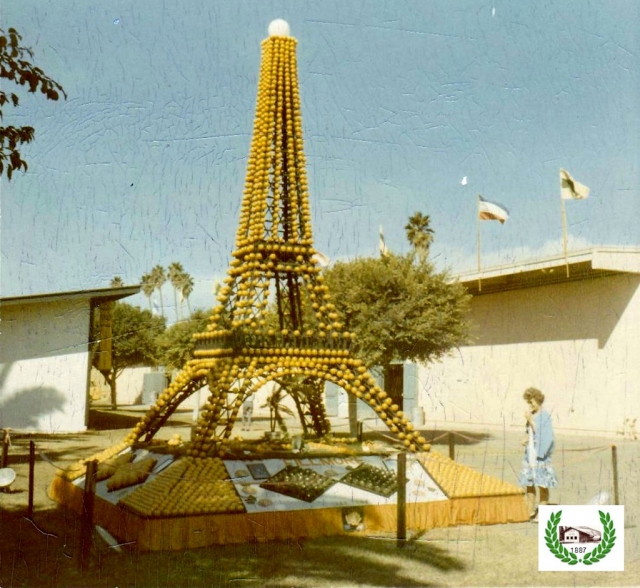 A citrus Eiffel Tower made with oranges in 1971 won the President’s Award at the Ventura County Fair as Fillmore Chamber of Commerce’s entry that year. Photos Courtesy Fillmore Historical Museum. Enlarge Photo By Gazette Staff Writers — Wednesday, December 29th, 2021
 Interior earthquake damage to Shirley's on Central Avenue in February 1971 after the Sylamr Quake. Enlarge Photo 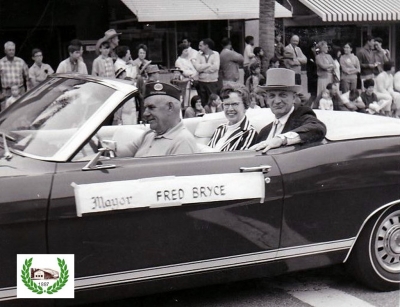 Mayor Fred Bryce, local CPA and captain of the Police Auxiliary, with Ruth Bryce in May Festival Parade. Enlarge Photo Courtesy Fillmore Historical Museum It’s traditional that as a year draws to a close to look back on the previous twelve months. Fifty years ago in December people in Fillmore did just that. So what happened in 1971? The first baby of the year was Cheryl Lynn Horn, daughter of Mr. and Mrs. Alan Horn. Fred Bryce, a local CPA and captain of the Police Auxiliary, was serving as Mayor. At 6 am on February 9th, Fillmore was awakened by an earthquake. The 6.5 Sylmar Quake was centered almost 27 miles from our town, but it caused damage especially to the east side of the business district on Central Avenue. A portion of the wall on what was then Briggs Hardware collapsed damaging not only that building but also Shirley’s Dress Shop next door. Repairs were made, but the upper floor of Briggs Hardware was never replaced. In October, fires threatened. A brush fire on Goodenough Road threatened several homes and prompted evacuations. At the same time, two human caused fires erupted on Guiberson Road, stretching fire personnel thin. Also in October, the Fillmore Chamber of Commerce entry at the Ventura County Fair was an Eiffel Tower made with oranges (similar to one done 50 years before) and won the President’s Award. The 1970 census counted the residents of Fillmore at 6,285, less than half of today’s population. Like today, Fillmore was undergoing a building boom with housing tracts being added throughout the town. Additionally, a motel was built as well as a “new” Safeway store (now Super A). The former Fillmore Theater underwent renovations and became the Town Theatre. On River Street, the Church of Religious Science, headed by Mildred Hinckley was opened. Africa USA was opened to the public mid-year, only to have its owner declare bankruptcy in December. The facility was taken over by Resorts International and continued to operate. At the High School, the basketball team had a 20-7 season. Debbie Dieter won the Lions Club Speech contest. Jose Gaitan was Senior Class President. 137 students graduated (up from 19 in 1921, fifty years before). Evangelyn Schiller was Valedictorian and Tim Gurrola was Salutatorian. There were 500 people in attendance at the Alumni dinner in June, 1971. Perhaps the biggest story of the year were the plans for the “Sespe Museum” created at the request pf the Chamber of Commerce. Edith Moore Jarrett would be the first curator with Dorothy Haase as assistant curator. It would be located on the ground floor of the Masonic Building and would open in 1972. This was the beginning of the Fillmore Historical Museum which will be celebrating its 50th Anniversary next year. Plan on joining us in the celebration. |
|
By Gazette Staff Writers — Wednesday, December 22nd, 2021
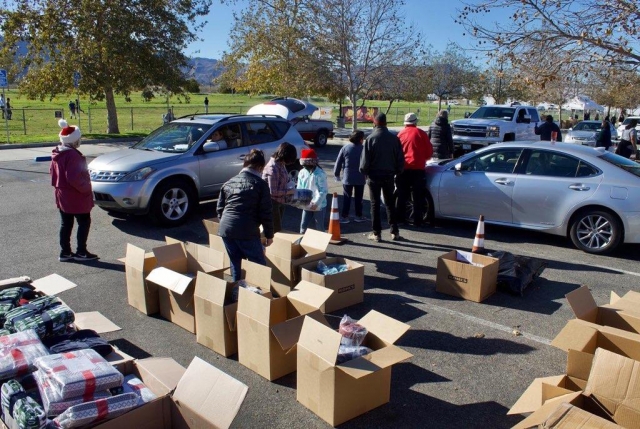 On Saturday, December 11th from 9am to noon at Fillmore’s Two Rivers Park, cars lined up for the Fillmore Community Holiday Giveaway. Families received age-appropriate toys, reading books and socks pre-packaged for pick-up. They also received blankets and a holiday bag of groceries if needed. Above and below, cars driving by to pick up their goodies, and volunteers helping package and hand them out. Photos courtesy Angel Esquivel-AE News. Enlarge Photo |
|
By Gazette Staff Writers — Wednesday, December 22nd, 2021
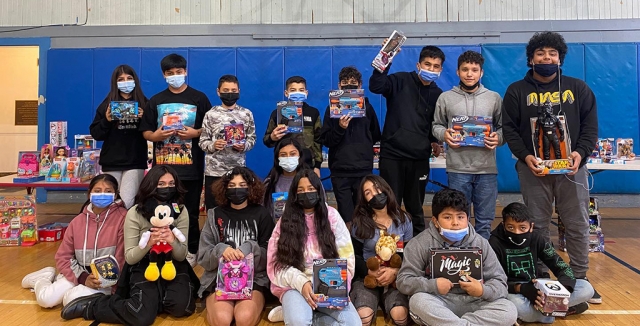 On December 15th, the Santa Clara Valley Boys & Girls Club gave a big shout out to @trusportz_company for the large donation of gifts to the Fillmore club. All the kids had an early Christmas. Photos courtesy SCV Boys & Girls Club Facebook page. Enlarge Photo |
|
By Gazette Staff Writers — Wednesday, December 22nd, 2021
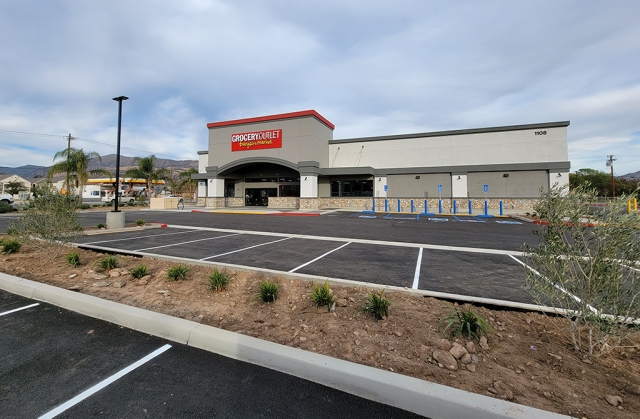 Fillmore’s Grocery Outlet has its new signs up and is preparing to open. Construction began in March of this year, and crews have worked non-stop to get the new outlet finished. The store is set to open in January 2022 according to Fillmore Grocery Outlet Facebook page. Enlarge Photo |
|
By Gazette Staff Writers — Wednesday, December 22nd, 2021
At the last City Council meeting, Duke Bradbury, Vice President of Thin Blue Line of Ventura County, proposed that the street immediately west of Central Avenue, adjacent to our Sheriff's Substation, be named for late former Sheriff Deputy Max Pina. The Gazette published a short history in last week's edition and promised to extend it for this week. Max's 53-years of public service could fill a book, but here are some primary reasons for supporting the naming of the street after Max Pina: He was Citizen of the Year for 1992. He was in service as a Fillmore police officer and then as Ventura County Sheriff's Deputy in Fillmore for over 20-years. Personal and professionally concern for Fillmore's youth. Spearheaded the raising of over $105,000 for the Fillmore Boys & Girls Club. Major coordinator of the Christmas Food Basket Program. Served as liaison officer between the gangs and local police. Received the second annual Baha'i Human Rights Award in 1990. Max was 1996 Employee of the Month. Selected Fillmore's first "Community Service Officer". Founding member of Fillmore Boys & Girls Club. Max was also instrumental in obtaining a grant of $18,000 for small neighborhood park next to the Storefront office, serving B&G Club. Recognition of Valuable Service to City of Fillmore 1999. Recognition of police officer since 1971. Leadership in Boys & Girls Club. Reduced crime and gang violence by work in North Fillmore Storefront. Won Medal of Valor for actions during 1978 floods, saving citizens trapped by flood waters with human chain of other officers. Max was awarded Officer of the Year in 1980 and 1983, also Optimist Club Distinguished and Dedicated Service Award, 1994. Dedicated Service Award to North Fillmore Storefront, "Providing positive presence after school programs, adult education, counseling and legal services, prevention programs and other activities. Provided safe place for persons wishing to contact police”. In 2003 the Storefront welcomed its one hundred thousandth visitor. It looks like our City Council will have plenty of information to basis its decision on. Thank you, Max Pina, for your life's work in the service of the City of Fillmore. |
 Oliva and her mother, homeowner Bene Ambrosio, with Sean McCulley. Ambrosio’s home was chosen for the Rotary Club’s House Painting Project. Photo courtesy Rotarian Martha Richardson. Enlarge Photo By Gazette Staff Writers — Wednesday, December 22nd, 2021
Initially, information and applications for Fillmore Rotary’s House Painting Project were handed-out to people who needed this work done but couldn’t personally or financially do it themselves. The applications were reviewed, and the project began. Several Rotarians sanded, scraped, and did all the prep work. Professionals took care of the termite problem and replaced new wood where needed and did the final painting. Rotarian Sean McCulley headed up this project and showed before and after photos to the Club. The owner of the property, Bene Ambrosio and her daughter, Oliva, were present to thank the club for the service project. |
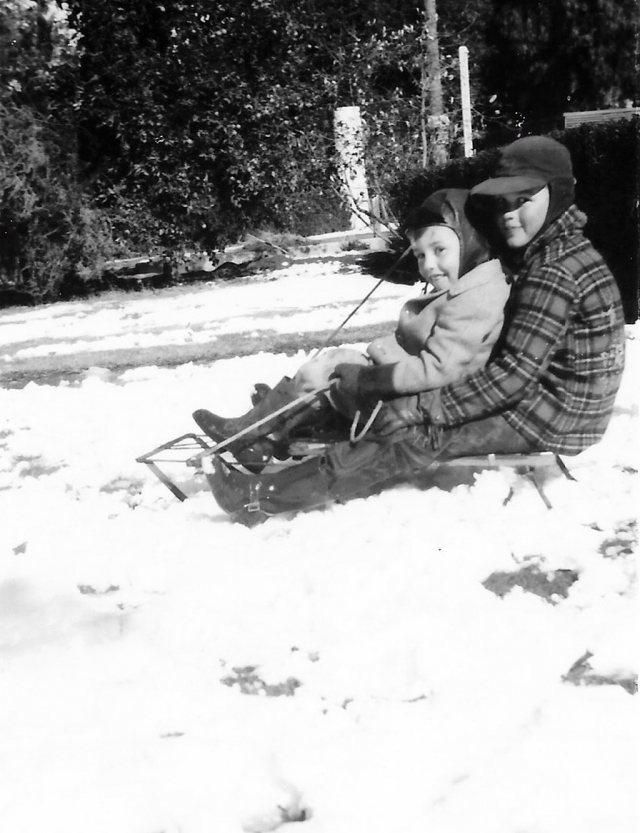 Phil and Fred Young enjoy Fillmore snow in 1949. Photos Courtesy Fillmore Historical Museum. Enlarge Photo By Gazette Staff Writers — Wednesday, December 22nd, 2021
Courtesy Fillmore Historical Museum As far as we know, Fillmore has never had a white Christmas, but a few weeks after Christmas in 1949 it seemed the entire area had been transported to the northern climes. Unseasonably cold weather hit the area from January 8th to January 12th, much of Southern California received measurable snowfall. It even snowed on Catalina Island! On January 8th, temperatures in Fillmore dropped to 28 degrees and remained low for almost a week. Citrus growers throughout the area lost much sleep keeping the smudge pots going in an attempt to save the navel orange crop which was just being harvested. School closed as did a few businesses. One business that did not close was the telephone exchange located on the ground floor of the Masonic Building. At that time, all calls had to go through an operator, there was no such thing as direct dial. On January 12, the number of calls almost doubled from a normal day of about 6,300 to more than 11,000. The previous high had been 8,000 calls. Gretchen Stanley, the chief operator, called in her staff so all 13 switchboards were covered. Apparently the high volume was due to the snowstorm, the low temperature, and the closing of the high school. According to Phil Young, “My brother Fred and I had, it seemed, endless play time in the white stuff. I also recall going with my dad, Merlin Young, in his pick-up to look at the snow around the area. On that little drive he stopped to talk with Brick Fansler. As ranchers do, they analyzed the situation and the possible impact on the orange crop. I was thinking: can we just go home for some more snow fun. Even though it was in January it truly was a white Christmas.” On Guiberson Road, Bill Shiells pulled son Bill and the neighbor kids around in the snow on the family toboggan. If you have snow photos you would like to share, post them to the museum’s Facebook page or send to the Museum at fillmore.museum@gmail.com. |
|
By Gazette Staff Writers — Thursday, December 16th, 2021
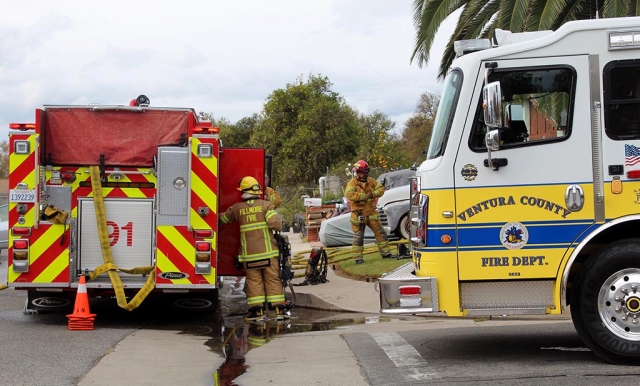 On December 13th, 2021, at 10:20am, Fillmore City Fire (E91) and Ventura County Fire were dispatched to a reported structure fire in the 800 block of 2nd Street, across from Fillmore Middle School. Arriving crews found an active fire and quickly knocked it down by 10:30am. AMR Paramedics were also requested to assess a smoke inhalation patient. Red Cross was notified for what was being described as two adults who were going to be displaced, according to radio traffic. Cause of the Fire is under Investigation. Photos courtesy Angel Esquivel-AE News. Enlarge Photo |
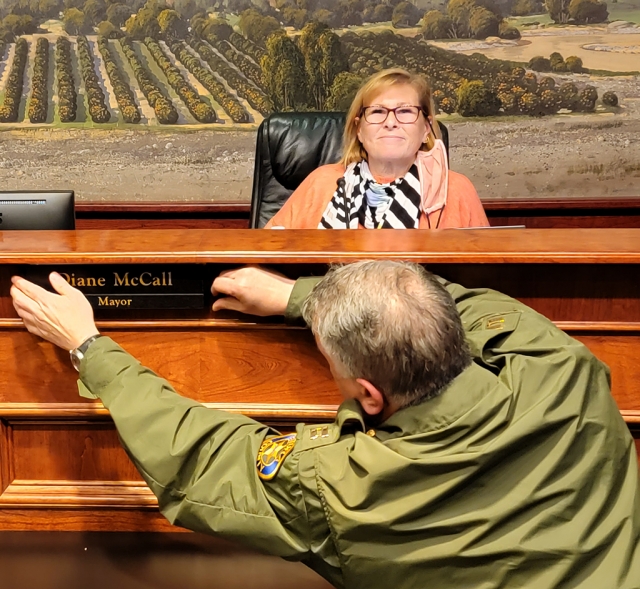 At Tuesday night’s city council meeting Fillmore’s Diane McCall was appointed Mayor of Fillmore. Enlarge Photo By Gazette Staff Writers — Thursday, December 16th, 2021
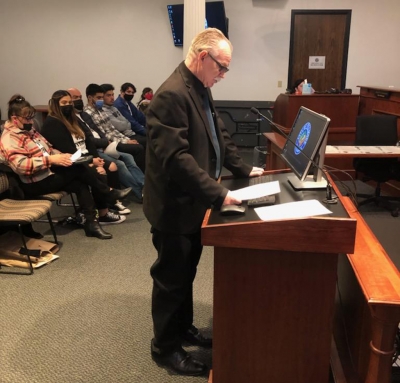 Duke Bradbury, Vice President of Thin Blue Line of Ventura County, presented to the City plans to name a street in remembrance of Fillmore’s former Fillmore PD Sgt. Max Pina. Enlarge Photo Council selected Diane McCall to be Fillmore's new Mayor, and Lynn Edmonds to be new Mayor Pro-Tem. 7.C The second reading to adopt Ordinance 21-933/Zoning Ordinance Amendment 21-02 to adopt the MWELO by reference, was approved. 7.D City Staff recommended that City Council approve an amendment to the current contract Professional Service Agreement with InfoSend, Inc. (InfoSend) of Anaheim, California, for an amount not to exceed a total of $120,000 for an additional 36-month (three year) period to continue providing data processing, printing, and mailing services to the City. Approved. 7.E. SWS Inc. Contract Amendment Solid Waste Contract. 7.F City Attorney Contract Amendment The City’s legal expenses can vary greatly from year -to-year depending on unanticipated legal matters such as claims and lawsuits. If the entire FY 2021-22 City Attorney budget of $295,000 will be expended this year, the proposed contract amendment would increase City Attorney costs by approximately $10,000. City Attorney contract amendment was unanimously Approved. 8.H Staff requested that the City Council accept a Fiscal Year (FY) 2020 Assistance to Firefighters Grant from FEMA. Approve an appropriation of $13,870 from the City’s general fund reserves to Fund 213; and 2. Approve the acceptance of FEMA FY 2020 AFG grant and authorize the City Manager or his designee to undertake any actions necessary to accept the grant. Your Fillmore Fire Department is in dire need of Cardiac Heart Monitors and Automated External Defibrillators (AEDs). Because of this need, Fillmore Fire Department has taken the lead on the FY 2020 AFG Regional Grant for monitors and AEDs. Of all grant items being awarded to the regional fire services, the monitors are the most expensive. The Fire Department is required to provide a heart monitor whenever we have paramedic staffing in place, which occurs almost daily. Acceptance of FEMA FY 2020 AFG grant is approved. |
|
By Gazette Staff Writers — Thursday, December 16th, 2021
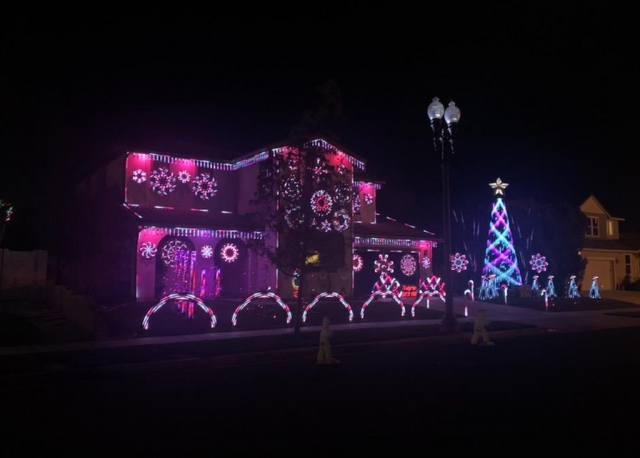 Christmas season is here! A holiday light and music show are on display at 408 Edgewood in The Bridges every night at 7:00, 7:30 and 8:00pm (past hours). The display includes music and visuals. You can tune into 97.7 FM on your car radio to listen to the Christmas music. Homeowner Ron Howard went all out to make sure this Christmas season is celebrated in Fillmore. Enlarge Photo |
 Fillmore Condors Cross Country team competed at the AAU National Cross-Country Championships against over 2,000 other athletes on Saturday, December 4th in North Carolina. Back Row: Leah Barragan, Kirsten Theobald, Lucy Zuniga, Abel Arana, Diego Felix, Kristen and Kaylie Theobald. Front Row: Athena and Caroline Villela, Mila Castro, Robert Marin Jr., Giovanni and Sophia Cortez, Itzel Arana, Zoey Zuniga and Kenzie Theobald. Photos Courtesy Fillmore Condors Cross Country President Erika Arana. Enlarge Photo By Gazette Staff Writers — Thursday, December 16th, 2021
 Fillmore Condors Destina Guzman who placed 12th overall, and 11th individually and Lucy Zuniga who placed 23rd overall finish and 19th individually, for the 10-year-olds. Enlarge Photo Courtesy Fillmore Condors Cross Country President Erika Arana The Fillmore Condors Cross Country team concluded their 2021 season by participating in the AAU National Cross-Country Championships on Saturday, December 4th, 2021. Although USATF was our first option, with Covid restrictions still stricter in Kentucky, we decided as a conference to travel to Charlotte, North Carolina instead. Roughly 2,000 athletes followed, to compete at the 114+ acres, known as the 5k Championship Cross-Country course at McAlpine Creek Park. This serene multi-use park has the deepest history of any course in North Carolina, and arguably of any course in the Southeast. It is legendary for its flat, fast surface that produces remarkable times, although it does have one steep decent-sized hill. Weather conditions felt just like California. This year we were able to have a full season, with athletes racing every Saturday to create an elite National team, based off rankings within the Valley Youth Conference. Our eighteen local Fillmore Condors joined other area runners to form Valley United Striders. Condor representatives were Leah Barragan, Mila Castro, Destina Guzman, Robert Marin Jr., and siblings, Abel, and Itzel Arana; Giovanni, and Sophia Cortez; Diego, and Santiago Felix; Kaylie, Kenzie, Kirsten, and Kristen Theobald; Athena, and Coraline Villela; Lucy and Zoey Zuniga. Beginning the day with the oldest division was the girls 13 and 14-year-olds, with 184 runners. Leah Barragan 137th overall and 88th, individually for the 13-year-olds; Leah had a time of18:17.65. The boys 13 & 14-year-old division had an impressive field of 219 runners. Diego Felix placing 143rd overall and 68th individually, for the 14-year-olds; PR 15:55.21. These two ran their last youth 3,000-meter (2.48 mile) race. Following were the girls 11 and 12-year-old division, which consisted of 217 runners. Kaylie Theobald placed 111th overall and 68th individually, for the 12-year-olds; 12:53.01. The boys 11 and 12-year-old division race, was the largest race of the day, stacked with 227 runners. Santiago Felix finished strong with a time of 11:42.78, placing 73rd overall and 41st in the 12-year-olds, individually. Right behind him, was teammate Abel Arana who crossed the finish line with a time of 11:50.42, placing 80th overall and 35th individually, for the 11-year-olds. Abel and his Strider teammates ran away with a 3rd place podium title, all running a 3,000-meter (1.86 mile) race. 169 runners toed the starting line in the girls 9 and 10-year-old race, with four of the Striders being Condors. This Strider team was favored to win, and that they did! 1st place National Champions podium appearance. Destina Guzman, was a completely different runner this season. She raced with confidence, placing 12th overall, and 11th individually for the 10-year-olds. Lucy Zuniga, behind her teammate, crossed with a time of 12:24.49 for a 23rd overall finish and 19th individually, for the 10-year-olds.Theobald sisters, Kirsten ran 12:36.36, 31st overall and 24th individually; Kristen struggled behind to hold onto her sister, running13:14.8, 63rd overall and 41st individually, both for the 10-year-olds. First time cross-country runner, Giovanni Cortez, raced against 167 runners. His time was 14:58.53, placing 145th overall and 63rd individually, for the 9-year-olds. This division ran the 3,000-meter race (1.86 mile) race. Itzel Arana was our top Condor and Strider runner all season, and she did not disappoint at Nationals, in the girls 7 and 8-year-olds division. She peaked a season PR time of 8:28.48, placing 12th overall and 9th individually, for the 8-year-olds. Teammates, and sisters, Caroline, and Athena Villela, also first time cross-county runners were in the same race of 105 runners. Caroline crossed the finish line at9:35.58, placing 58th overall and 41st individually, for the 8-year-olds. Her sister Athena placed 99th overall, and 37th for the 7-year-olds, running 11:20.60. Both sisters also hit season PR’s. Itzel and Caroline earned a 2nd place podium finish in their 2,000-meter (1.24 mile) race. The last combined race of the day concluded with the 6U’s, in a field of 67 boys and girls. The girl’s first National experience was one to remember, as our Condor girls took home a National Champion team title. Mila Castro speed her way to a time of 5:08.34 for a 13th place finish. Seven seconds behind in 18th place, was Sophia Cortez; 5:15.83. Teammates, Zoey Zuniga, and Kenzie Theobald paced off each other to finish milliseconds away from one another. Zoey 21st; 5:25.32, and Kenzie, 22nd,5:25.82. The only Condor boy to represent was, Robert Marin Jr. who finished 22nd for the boys; 4:57.58. All the 6u’s ran 1,000-meter (.62 mile) race. Fillmore Condors Cross Country is a non-profit organization under Heritage Valley Blazers Inc. We are the only cross-country team in Fillmore; we represent our city with pride. The Condors are coached by Gerardo Flores, Jared Perez, Jessica Huerta, Angel Venegas, Sandy, and Felix “Punkie” Zuniga. “Every year is a new experience. We are always amazed to see what these athletes’ minds and bodies endured in the 4.5 months of training for Nationals. They never disappoint!” Condors President Erika Arana and board members would like to thank the following for sponsoring our athletes this memorable cross-country season: Fillmore Lions Club, Fillmore Rotary Club, Heritage Valley Blazers Inc., and the Fillmore Community for purchasing Jamba Juice cards from our athletes. For more XC or Track info, contact 805-624-1129. FOREVER CONDORS! |
 On Saturday, December 11th, Piru hosted their 43rd Annual Christmas Parade & Festival. There were over 20 entries, food trucks, local eateries, music and pictures with Santa. (Above) Mrs. Claus, Donna Perez, and reindeers Donner and Blitzen. Photo courtesy Lisa Crockatt. Enlarge Photo By Gazette Staff Writers — Thursday, December 16th, 2021
Courtesy Piru Neighborhood Council The Piru 43rd Annual Christmas parade and festival drew most of the town out to celebrate this past Saturday. The VFW Color Guard led the procession of over 20 entry's included Parade floats, fire station 28, Ventura Sheriff Search and Rescue, and United Water Piru Lake vehicle and rescue boat, Fillmore High school band, local 4-H Club, Boys & Girls Club and multiple other entries. ROKK Plumbing float, The Grinch float, Ruiz Family float and the FHS Marching Band were the parade winners. Following the parade, music was provided by: Mariachi Los Rayos from Fillmore High, Piru River Band, Hard Water Band, and DJ Dan Ibarra. Food trucks and local eateries were on hand, as were multiple vendors featuring a myriad of crafts and other items. Phil's animals oversaw the arrival of Mrs. Santa Claus and a few of Santa’s favorite reindeer who hung around so the children could have their pictures taken with them. The event was hosted by the Piru Neighborhood Council and several community volunteers. The afternoon included a Camoulus local history tent, Ventura County Library van, a corn hole tournament, toy give away by the Carnales Motorcycle Club, and more. The afternoon was well attended and this year's ever honored Michele McKinley in appreciation for her passion for our community, along with her continuous efforts to promote the rich history of Piru. The event received several local Business and personal donations to fund the event, most notably over $2,500 that was donated by a few recent film productions. |
|
By Gazette Staff Writers — Thursday, December 16th, 2021
Fillmore Civic Pride Committee is pleased to award the Holiday “Yard of the Month” to Roy, Raquel, and Irma Hernandez at 969 5th Street. The Hernandez family has lived in their home since 2009 and they enjoy being in an area where lots of people pass by, walking their dogs or going to the park. They take great pride in their yard and want people to enjoy it. They like hearing people commenting on their beautiful flowers. Irma said they especially love roses and had been saying they needed to get more for the yard. Both Roy & Raquel are retired, so they do all the gardening, but Irma, having been trained in design at Brooks College, likes coming up with the design & even climbs on the ladder to get it put up. The Hernandez family were very happy to receive the $50 award provided by Otto & Sons Nursery. They are certain to be amazed when they see the fantastic selection of roses &other plants available, as well as the new demonstration gardens to walk around. Otto & Sons Nursery has generously been supporting our “Yard of the Month” awards since they began in 2003. This year there were so many neighborhoods lit up with beautiful displays. We try to spread the awards around the community. Please take your family out for sightseeing and be sure to check out former winners on Sespe St, Robin Court and Edgewood in the Bridges. Other noteworthy streets would be C St., Parkhaven, Mockingbird and Meadowlark, Mountain View, Lora Lane, Saratoga, Foothill and Shady Lane in the Traditions neighborhood. Civic Pride Committee invites all who are interested in beautifying our community, to our next meeting, January 19, 2022, at 1:30pm in the City Hall conference room. |
|
By Gazette Staff Writers — Thursday, December 16th, 2021
Dear FUSD Community, Please see the message below from Ventura County Superintendent of Schools, Dr. Cesar Morales regarding social media threats and bullying across Ventura County. We ask all families to have conversations with their children regarding social media use and report any inappropriate activity to school personnel. The safety of our staff and students are our number one priority and we take all threats and bullying incidents seriously. Additionally, when we are made aware of any inappropriate social media sties, we immediately notify the social media platform administrators and law enforcement, as appropriate. We are also very fortunate to have counselors at all our school sites and a new Wellness Center with a licensed social worker at Fillmore High School. Let’s continue to work together, build relationships, and strengthen our school environments so students feel safe, cared for, and supported. Thank you, Responding to Social Media Threats and Bullying Across the country and here in Ventura County, schools are seeing a concerning increase in students making inappropriate and potentially dangerous posts to social media, particularly on Instagram. These posts have included threats of violence and embarrassing pictures of students and staff members who didn’t know they were being photographed. In some cases, students create accounts that fraudulently appear to represent their school. Just yesterday, a social media threat created a significant disturbance at Oxnard High School and led to the suspension and arrest of the student suspected of posting it. With help from the Oxnard Police Department, the Oxnard Union High School District determined the threat was not credible. However, the disruption it created for students, staff and families is very real, as are the consequences students can face when they are caught engaging in inappropriate social media activity. “Students need to understand that posting threatening and harassing material to social media is no joke,” said Dr. César Morales, Ventura County Superintendent of Schools. “I urge all parents to talk to their children about this issue and explain that inappropriate online behavior can have serious consequences in the real world. Working together, educators and families can help ensure that schools are safe and supportive places for students to learn and grow.” Schools do report inappropriate and fraudulent accounts to the social media platforms, but there is often a delay before they are taken down, and sometimes they are not removed at all. Here are some steps that parents, guardians and caregivers can take to help address this problem: Be aware of your child’s online activity; they may have multiple accounts on the same platform. Remind students that while they may feel anonymous online, their identity can be revealed through technological means and if other students report them. Let students know that they should inform a trusted adult if they’re aware of inappropriate social media activity. You can find additional tips on talking to students about social media from Common Sense Media at www.commonsensemedia.org/social-media. It’s also important for families to be aware of their school and district’s authorized social media sites. The Ventura County Office of Education has created a list of the official social media accounts for all of the county’s 20 school districts, which is available at www.vcoe.org/vc-districts. |
|
By Gazette Staff Writers — Thursday, December 16th, 2021
 Japanese bunkhouse/dormitory, circa 1914. The bunkhouse housed unmarried Japanese workers, and the dormitory was opened to the outside rather than to an interior hall. Photos courtesy Fillmore Historical Museum. Enlarge Photo  Rancho Sespe Headquarters with Bunkhouse #2 facing north and Bunkhouse #1 facing east, circa 1925. Enlarge Photo Courtesy Fillmore Historical Museum The Rancho Sespe Bunkhouse #2 is one of thebuildings at the Fillmore Historical Museum and houses a major portion of our collection. It was moved to its current site in 1995 having been donated to the Museum by James P. Finch who had bought the Rancho Sespe headquarters parcel. As the name implies, this was not the first bunkhouse on Rancho Sespe, in fact it was the third. All of the bunkhouses were built while the property was owned by Eudora Hull Spalding who had inherited half the property from her father and had subsequently bought out her brother’s share and became the sole owner of the 2,200 acre tract. By the time of her death in 1942 the ranch had been expanded to 4,300 acres and had become an internationally known showcase for its advances in citrus cultivation. Besides citrus, it grew walnuts, hay, beans and other crops as well as including pasture lands for its horses and cattle. It was a self-contained community which employed over 200 people. From 1911 to 1919 three bunkhouses were built to house unmarried workers. The architecture firm of Greene and Greene of Pasadena was hired to design Rancho Sespe Bunkhouse #1 which still stands at the former headquarters site approximately 4 miles west of Fillmore. The actual design was probably done by a draftsman at the firm which was best known for designing Craftsman style bungalows such as the Gamble House in Pasadena and not utilitarian bunkhouses. The primary builder of the bunkhouse was Harry Peyton who had come to Fillmore with the Southern Pacific Railroad. In the March, 1918 edition of California Citrograph, Sespe Ranch Manager Walter H. Fleet described the bunkhouse as a“two-story building, 80ft. by 45 ft., and consists of a large living room, dining room for the general class of employees, private dining room for officials, kitchen, washroom, three bathrooms, three toilets, linen room, storeroom and 20 separate sleeping rooms on the second floor…. Each room has a large window and is furnished with following: one iron bed and springs, one mattress, two sheets, two blankets in summer and three in winter, one pillow, one white pillow cover, one bedspread, one chair, one table and closet with a curtain as dust protector…. Clean sheets for the beds are furnished twice a week, and clean towels in the washroom are furnished every day…, Hot water for the baths is furnished twice a week. The method of heating is by stove distillate burners, which heat a 200 gallon tank very quickly. In the living roomthere are card tables, a large library billiard table and large wood heating stove.” For its time, the Rancho Sespe Bunkhouse #1was an especially comfortable bunkhouse with modern conveniences. We do not know as much about the second dormitory’s history but know it was built by 1914. This bunkhouse housed unmarried Japanese workers. The dormitory was similar to Bunkhouse #1, but the rooms opened to the outside rather than to an interior hall. Again according to Walter Fleet: “The building contains a living room, dining room, large kitchen with Japanese cook stoves, 10 sleeping rooms upstairs and four downstairs….The ranch furnishes one bed and springs, one mattress, one table, one chair. The occupants furnish their own bedding and board themselves. In the dining room are two long tables and seating benches for 50 people. One feature of the Japanese quarters is their large bathhouse. This building is 40 ft. by 27 ft. with cement floor throughout. Here are located the toilets and washroom, and in the center is a large concrete tank for bathing 10 ft. by 3 ft. deep. Hot water is furnished by a wood or oil heater which heats a tank of 300 gallons. There are also two shower baths in the building.” The third bunkhouse, Rancho Sespe Bunkhouse #2 which now is part of our Museum, was built in 1919. Again we believe that Harry Peyton was the primary carpenter but this has not been confirmed. The twenty-eight sleeping rooms were similar to the ones in Bunkhouse #1. Toilet facilities were provided in Bunkhouse #2, but the workers used the dining, recreation and shower facilities in Bunkhouse #1. In 1937, Edward Wyman Spalding, a cousin of Keith Spalding, had just gotten out of the Navy and came to work as a ranch hand at Rancho Sespe. He lived in one of the bunkhouses and in the Ventura County Historical Quarterly, Volume 38, 1993, described the experience thusly: “We all breathed the same air. And heard the same sounds. At least on Sundays. Each of the other men, it seemed, had his own radio, little things – we’d call them antiques now – and all through the week when we weren’t at work, each of those radios would have its own music, what we’d call “country” now. It was fairly chaotic. But not on Sunday. Sunday all of those little jobs would be tuned to Aimee Semple MacPherson’s “Foursquare Church,” and Aimee’s voice would be echoing off the rafters. Loud. Very Loud.” Change the music being played and the Sunday sermon, and it sounds very much like a college dormitory. |
|
By Gazette Staff Writers — Wednesday, December 8th, 2021
 On Saturday, December 4th, at 10am, the Fillmore Lions Club held their Annual Christmas Parade. Crowds of people lined up along Central Avenue to enjoy the fun. Santa and Mrs. Claus took a ride on the back of Fillmore Fire Engine 91 along with Fillmore City Council Members to end this year’s parade. Photos courtesy Angel Esquivel-AE News. Enlarge Photo |
|
By Gazette Staff Writers — Wednesday, December 8th, 2021
 A huge thank you goes out to our community organizations that made this 30-foot Christmas tree possible for the holiday season, as well as to our amazing Fillmore Fire Department who assembled and decorated the holiday tree for all to enjoy. The City of Fillmore’s Holiday Tree Lighting held at Central Park was on Wednesday, December 1st. The festivities began with lighting of the tree and live music for all to enjoy. Thank you to all the sponsors and performances: Fillmore Association of Businesses- FAB Page, Sespe Creek Bible Church, Bardsdale Methodist Bell Choir and Fillmore City Fire Department. Courtesy City of Fillmore Facebook page. Enlarge Photo |

